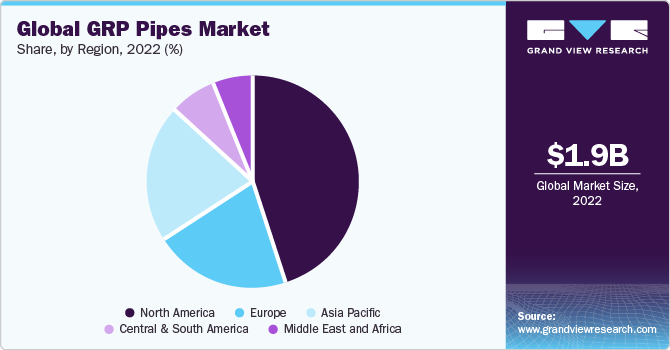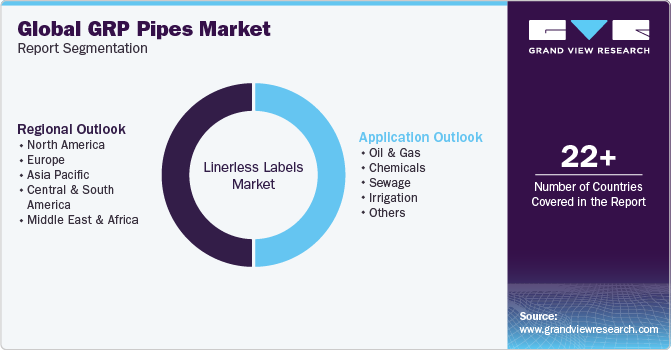- Home
- »
- Specialty Glass, Ceramic & Fiber
- »
-
GRP Pipes Market Size And Share Analysis Report, 2030GVR Report cover
![GRP Pipes Market Size, Share & Trends Report]()
GRP Pipes Market Size, Share & Trends Analysis Report By Application (Oil & Gas, Chemicals, Sewage, Irrigation, Others), By Region (North America, Europe, Asia Pacific, Central & South America, MEA), And Segment Forecasts, 2023 - 2030
- Report ID: GVR-3-68038-612-7
- Number of Report Pages: 96
- Format: PDF, Horizon Databook
- Historical Range: 2018 - 2021
- Forecast Period: 2023 - 2030
- Industry: Advanced Materials
GRP Pipes Market Size & Trends
The global GRP Pipes market size was valued at USD 1,856.5 million in 2022 and is anticipated to grow at a CAGR of 3.2% from 2023 to 2030. Rising demand for high-strength, durable, and lightweight pipelines for water, wastewater, and chemical supply for industrial applications is expected to drive the industry growth over the forecast period. At present, very few major manufacturers dominate the glass fiber reinforced plastic (GRP) pipes industry with robust manufacturing facilities and widespread geographic distribution. High initial investments and operational costs associated with the manufacturing of GRP pipes are likely to be the major entry barriers for new market players.

The U.S. has emerged as one of the largest markets for GRP pipes in North America owing to high investments by the government in water treatment and the potable water supply industry. Increasing shale gas exploration activities in the country, which demand durable piping solutions, are likely to have a positive impact on the growth of the GRP pipes market over the projected period.
Manufacturers tend to offer standard product lines as the costs associated with fabrication and the engineering involved in custom product manufacturing are very high. However, they also provide custom GRP pipes for specific application industries, which are usually manufactured based on the requirements presented by end-users. The centrifugal method, wherein the outer pipe diameter is constant, produces a high-quality product. However, the process is highly labor-intensive and not cost-effective, which is likely to hamper its demand.
The European Union (EU) has laid down Safety Glass Directives for GRP piping utilized in construction, water treatment, and automotive applications. The directive also covers the fitting and installation of these products. The pipes adhere to stringent regulations about mechanical and chemical strength.
Application Insights
The irrigation segment accounted for the largest revenue share of 38.5% in 2022. GRP pipes provide numerous benefits in irrigation applications. Their outstanding corrosion resistance makes them ideal for transporting water over extended periods without experiencing degradation. This feature becomes especially advantageous when handling fertilizers, pesticides, and other agricultural chemicals, which can be corrosive and harmful to traditional metal pipes. Furthermore, the smooth internal surface of GRP pipes minimizes frictional losses, ensuring the efficient flow of water across vast distances, and promoting an effective irrigation system. Growth of the agricultural sector to support the rising demand for food is expected to propel the demand for well-established water infrastructure, which, in turn, is likely to positively impact the glass fiber reinforced plastic pipes market growth.
The sewage segment is expected to grow at a CAGR of 3.2% during the forecast period. GRP pipes are widely used in sewage treatment facilities on account of their ability to resist corrosion caused by toxic chemicals during the treatment. The smooth internal surface of GRP pipes prevents the buildup of debris and organic matter, reducing the risk of clogging and blockages in the system. Increasing government mandates on industrial effluent collection, processing, and recycling are expected to propel the demand for the product over the projected period. Additionally, as sewage systems are usually spread in the shape of extensive networks covering large areas, the lightweight nature of GRP pipes becomes advantageous, making installation and maintenance activities more manageable and cost-effective.
Regional Insights
Asia Pacific dominated the market and accounted for the largest revenue share of 44.7% in 2022. India is expected to be the fastest-growing market for GRP pipes in the region. The availability of skilled labor, favorable government regulations, and high demand from end-users are likely to compel manufacturers to set up their production facilities in this region.

In 2022, China was the largest consumer of pipes in the Asia Pacific owing to the presence of numerous chemical manufacturing companies in the country. High population density and the government’s focus on reducing dependency on imports are driving the agricultural sector in the country. As a result, the demand for GRP pipes for use in irrigation applications is expected to rise over the projected period.
Europe is expected to grow at a CAGR of 2.5% during the forecast period. Europe's extensive network of infrastructure projects, industrial developments, and environmental initiatives creates a demand for reliable and cost-efficient solutions to transport fluids and waste. GRP pipes, known for their exceptional strength-to-weight ratio, resistance to corrosion, and long-lasting performance, are ideally suited to cater to Europe's diverse needs.
Key Companies & Market Share Insights
The industry is highly competitive with a low number of manufacturers competing based on product quality and distribution networks. Increasing efforts by manufacturers toward quality enhancement and new product development are likely to trigger the demand for GRP pipes across various application industries. Strategies such as diversified portfolio, brand reputation, and enhanced product quality are considered to be the key success factors in the market. Major players are expected to invest in strategies such as joint ventures, mergers & acquisitions, and long-term contracts with users to gain a competitive advantage and sustain in the competitive market.
Key GRP Pipes Companies:
- Amiblu Holding GmbH
- Saudi Arabian Amiantit Co.
- ADPF (Abu Dhabi Pipe Factory)
- Hengrun Group Co., Ltd.
- Graphite India Limited
Recent Developments
-
In April 2023, Perma-Pipe International Holdings announced that it had won two contracts with a combined value of over USD 8 million. The first project would involve laying insulated pipe infrastructure for a thermal distribution system in Fanshawe college, London. The second contract would involve providing thermally insulated pipes to China Petroleum & Chemical Corporation for a project in Uganda. The projects reaffirm the need of GRP pipes in the oil and gas industry based in Middle East and Africa.
-
In April 2022, GF Piping Systems unveiled their offering, 'HEAT-FIT,' a state-of-the-art thermoplastic piping system designed for industrial and wastewater treatment applications. This innovative product has a corrosion-free, lightweight, and efficient design. Compatible with the ecoFIT range, which comprises polyethylene pipes and fittings, the 'HEAT-FIT' system incorporates a dual-layer jacket made of thermoplastic polyurethane (TPU), featuring an intumescent coating and high-temperature fiberglass fabric.
GRP Pipes Market Report Scope
Report Attribute
Details
Market size value in 2023
USD 1,926.4 million
Revenue forecast in 2030
USD 2.39 billion
Growth Rate
CAGR of 3.2% from 2023 to 2030
Base year for estimation
2022
Historical data
2018 - 2021
Forecast period
2023 - 2030
Report updated
October 2023
Quantitative units
Revenue in USD million and CAGR from 2023 to 2030
Report coverage
Revenue forecast, company ranking, competitive landscape, growth factors, and trends
Segments covered
Application, region
Regional scope
North America; Europe; Asia Pacific; Central & South America; MEA
Country scope
U.S.; Canada; Mexico; Germany; France; Italy; UK; Spain; China; India; Japan; South Korea; Thailand; Australia; Brazil; Saudi Arabia
Key companies profiled
Amiblu Holding GmbH; Saudi Arabian Amiantit Co.; ADPF; Hengrun Group Co., Ltd.; Graphite India Limited
Customization scope
Free report customization (equivalent up to 8 analyst’s working days) with purchase. Addition or alteration to country, regional & segment scope
Pricing and purchase options
Avail customized purchase options to meet your exact research needs. Explore purchase options
Global GRP Pipes Market Report Segmentation
This report forecasts revenue growth at global, regional, and country levels and provides an analysis of the latest industry trends in each of the sub-segments from 2018 to 2030. For this study, Grand View Research has segmented the global GRP Pipes market based on application, and region:

-
Application Outlook (Revenue, USD Million, 2018 - 2030)
-
Oil & Gas
-
Chemicals
-
Sewage
-
Irrigation
-
Others
-
-
Regional Outlook (Revenue, USD Million, 2018 - 2030)
-
North America
-
U.S.
-
Canada
-
Mexico
-
-
Europe
-
UK
-
Germany
-
France
-
Italy
-
Spain
-
-
Asia Pacific
-
China
-
Japan
-
India
-
Australia
-
Thailand
-
South Korea
-
-
Central & South America
-
Brazil
-
-
Middle East and Africa
-
Saudi Arabia
-
-
Frequently Asked Questions About This Report
b. The global GRP pipes market size was estimated at USD 1,856.5 million in 2022 and is expected to reach USD 1,926.4 million in 2023.
b. The global GRP pipes market is expected to grow at a compound annual growth rate of 3.2% from 2023 to 2030 to reach USD 2.39 billion by 2025.
b. Asia Pacific dominated the GRP pipes market with a share of 44.7% in 2022. This is attributable to Availability of skilled labor, favorable government regulations, and high demand from end-users.
b. Some key players operating in the GRP pipes market include Amiblu Group; Saudi Arabian Amiantit Co.; Abu Dhabi Pipe Factory; Hengrun Group Co., Ltd.; and Graphite India Limited.
b. Key factors that are driving the market growth include rising demand for high strength, durable, and lightweight pipelines for water, wastewater, and chemical supply for industrial applications.
Share this report with your colleague or friend.
![gvr icn]()
NEED A CUSTOM REPORT?
We can customize every report - free of charge - including purchasing stand-alone sections or country-level reports, as well as offer affordable discounts for start-ups & universities. Contact us now
![Certified Icon]()
We are GDPR and CCPA compliant! Your transaction & personal information is safe and secure. For more details, please read our privacy policy.
We are committed towards customer satisfaction, and quality service.
"The quality of research they have done for us has been excellent."





